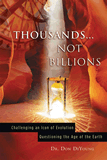
RATE: Overturning Millions of Years
There have been many claims in the media, science journals, and documentaries that creationists scientists do not perform original research. However, as the number of creationist researchers continues to grow, this claim is now clearly without foundation. Not only have creationist organizations performed ground-breaking, well-documented research, they have also shed new light on the flaws of a millions-of-years mindset. As Dr. Andrew Snelling explains, creation research is entering a new phase of exciting breakthroughs:
Too long ago to matter?
Click above to view a segment from the DVD, Rocks of Ages or Rock of Creation.
The 1997–2005 RATE (Radioisotopes and the Age of the Earth) research project at the Institute for Creation Research (co-sponsored by the Creation Research Society) demonstrated that creationists could support a larger-scale collaborative research effort, particularly if it delivered significant breakthroughs on a key challenging issue. The primary focus of this research effort was the radioactive methods for dating rocks that supposedly yield age estimates of millions and billions of years and thus provide support for the claimed multi-billion year age for the earth.
Because of the RATE research results, the long-age radioactive methods for dating rocks can now be more easily demonstrated to often be faulty, since there are problems with the three crucial assumptions on which they are based:
- There are uncertainties as to the absence or presence of daughter atoms (atoms left after decay) when the rocks formed, because there is much evidence of the rocks having inherited daughter atoms that were not formed by radioactive decay in those rocks.
- There is abundant evidence of widespread “open-system” behavior of parent and daughter atoms. Rocks are often contaminated with extra parent and daughter atoms produced apart from radioactive decay. Parent and daughter atoms are also removed by various geologic processes (for example, leaching by fluids) subsequent to the rocks forming.
- Nuclear decay rates have now been demonstrated to have not always been constant.
Much research, even reported in the conventional scientific literature, has found that rocks of known age often yield erroneously old radioactive age estimates because either one of the first two assumptions, or both, can be demonstrated to be false. And if the radioactive “clocks” have not always “ticked” at the currently measured slow rates but were grossly accelerated in the past, then these radioactive dating methods cannot be used to provide reliable age estimates for rocks. After all, if these “clocks” don’t work on rocks of known ages, how can they be trusted on rocks of unknown ages? To be sure, there is a systematic trend of radioactive age estimates for rocks according to their positions in the geologic record, but this would be expected if nuclear decay was grossly accelerated systematically when the rock layers were forming. For example, rocks laid down early in the Flood would yield older ages than rocks laid down later during the Flood because the earlier rocks would have experienced more accelerated radioactive decay.
Want to learn more?
Read the rest at: Radioisotopes and the Age of the Earth and Radiocarbon in Diamonds Confirmed.
Get Involved
Please prayerfully consider supporting future research, conferences, videos, and publications that uphold God’s Word.
Recommended Resources

Answers in Genesis is an apologetics ministry, dedicated to helping Christians defend their faith and proclaim the good news of Jesus Christ.
- Customer Service 800.778.3390
- Available Monday–Friday | 9 AM–5 PM ET
- © 2026 Answers in Genesis

